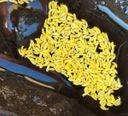Onychiuridae
Onychiuridae
Classification
- Phylum: Arthropoda
- Subphylum: Hexapoda
- Class: Collembola
- Order: Poduromorpha
- Superfamily: Onychiuroidea
- Family: Onychiuridae
Pronunciation
How to pronounce Onychiuridae: /ˌɒnɪˈkjʊrɪdiː/
These audio files are automatically generated. While they are not always 100% accurate, they are a good starting point.
Images

Summary
Onychiuridae is a family of small, soil-dwelling springtails (Collembola) crucial for nutrient cycling in terrestrial ecosystems, showcasing significant diversity worldwide with a variety of genera.
Physical Characteristics
The Onychiuridae family includes small, wingless arthropods characterized by their elongated bodies and presence of antennae. They may exhibit varying pigmentation patterns, generally pale to dark brown, depending on the species.
Identification Tips
Look for the distinctive body shape and the segmented antennae. Examination under a microscope may reveal unique cuticular structures that help differentiate between genera and species.
Habitat
Onychiuridae are typically found in moist environments such as leaf litter, soil, and decaying organic matter. They thrive in humus-rich substrates.
Distribution
This family includes approximately 600 species worldwide, with over 40 species identified in various regions including temperate and tropical areas.
Diet
Onychiuridae are detritivores, primarily feeding on decaying organic matter, fungi, and microorganisms found in their habitats.
Life Cycle
The life cycle consists of egg, juvenile, and adult stages, with development occurring through a series of molts. Juveniles are similar in appearance to adults but smaller.
Reproduction
Reproduction is sexual, with females ovipositing eggs into suitable substrates, where the juvenile stages emerge after a brief incubation period.
Predators
Natural predators include various soil-dwelling arthropods, such as predatory mites and compacted soil macrofauna.
Ecosystem Role
They play a critical role in soil health by contributing to the decomposition of organic matter, aiding nutrient cycling, and improving soil structure.
Collecting Methods
- Soil core sampling
- Leaf litter collection
- Pitfall traps
Preservation Methods
- Ethanol preservation
- Drying and mounting on slides
Evolution
Onychiuridae display a diverse evolutionary history with morphological adaptations that allow them to thrive in a variety of ecological niches.
Similar Taxa
Misconceptions
Often confused with pests or larger insects, Onychiuridae are harmless and beneficial to the environment rather than detrimental.
Tags
- Collembola
- springtails
- detritivores
- soil health
- ecosystems